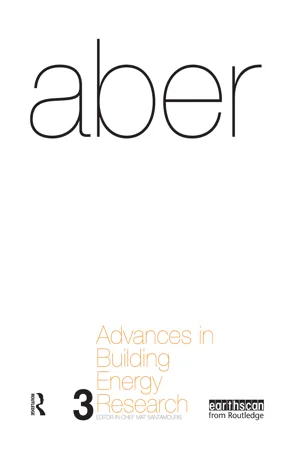INTRODUCTION
An essential element in promoting the rational use of energy is that decision makers be given access to relevant sources of information. These include energy demand profiles and characteristics of potential sources of supply; and the outputs from studies to assess the impact of possible alternative strategies. However, indications are that at present comprehensive information is rarely in the hands of those who require it and the use of modelling in strategy formulation is virtually unknown. This chapter describes projects that imply an attempt to change this situation.
The worldwide building stock (residential and commercial) is responsible for more than 33 per cent of global CO2 emissions (de la Rue du Can and Price, 2008) and a large mitigation potential has been identified (Urge-Vorsatz and Novikova, 2008). To attain aspirational CO2 reduction targets, such as the EU’s 20 per cent reduction by 2020 or the UK’s 60 per cent reduction by 2050, will require the implementation of radical construction upgrades, new technology deployments and, contentiously, lifestyle change.
The simplified energy/carbon calculators presently in use, such as defined in CEN Standard 13790 (ISO, 2007) or the UK’s Standard Assessment Procedure (BRE, 2005), are based on energy balance methods that do not account fully for the dynamic characteristics of buildings; Figure 1.1 contrasts graphically the energy balance underlying a simplified and simulation-based approach. Simplified methods cannot adequately represent the performance of the myriad upgrade options that may be applied individually or in combination. Also, as buildings have extended lifetimes, it is important to assess performance under likely future contexts, such as occupant behavioural change, climate change and the emergence of new technologies.
There are many available building simulation tools (Crawley et al, 2008) and these offer considerable advantages over their simplified counterparts, particularly in the areas of dynamic building response, adaptive occupant comfort, ventilation, indoor air quality, novel control and renewable energy systems integration. The simulation approach is increasingly being mandated in building performance legislation and applied in studies to inform policy.
Crawley (2007a, 2007b) reported on a simulation-based study to assess the impact of climate change and urban heat island effects on future building performance. A method was developed and applied to generate future weather collections for 25 locations in 20 climate zones around the world. This resulted in 525 weather collections encapsulating recent urban heat island data and the four economic scenarios and general climate assumptions of the Intergovernmental Panel on Climate Change. The intention is to use these collections to establish future climate impacts for a range of building types after various energy performance enhancements have been applied. To date, a model representing 25 per cent of the US office stock has been simulated for US locations, with three levels of enhancement applied corresponding to current practice, best practice and future practice scenarios. The results give the impact on heating and cooling energy use for combinations of location, climate change and selected efficiency measures.
Heiple and Sailor (2008) investigated energy supply and heat island effects by simulating building energy use at the urban scale. Their approach employed prototypical models representing 8 dwelling and 22 non-dwelling types. Entire districts were then mapped to these models using geographical information system (GIS) techniques and simple surveys. The energy use predictions were then communicated to policy-makers via GIS overlays. The researchers reported agreement with utility data to within 10 per cent.
Research at Osaka University characterized urban energy performance via the use of simulation models that included stochastic algorithms to represent variations in usage patterns. The method was initially demonstrated for two large offices supplied by cogeneration plant and absorption chillers (Yamaguchi et al, 2003). A second study (Hashimoto et al, 2007) focused on two office districts of different density and investigated various energy supply solutions (e.g. district heating/cooling and water/air source heat pumps). A third study (Taniguchi et al, 2007) investigated residential energy use. Models were constructed corresponding to 228 residential categories differentiated by family and building type and five insulation levels based on property age. The residential sectors of 20 Japanese cities were then mapped to these categories and the models, after calibration by comparison with utility data, used to investigate the efficacy of energy efficiency measures, including reduced appliance use based on Japan’s ‘top-runner’ policy, increased insulation, improved air conditioner efficiency and modified temperature setpoints.
In the UK, the Carbon Vision project (Carbon Trust, 2008) set out to provide the strategy and evidence base to allow the UK to meet its 60 per cent carbon reduction goal by 2050. The Technology Assessment for Radically Improving the Built Asset Base (TARBASE) sub-project carried out dynamic simulation modelling for representative building types in order to determine the applicability and likely impact of specific upgrade measures. Preliminary results indicate that a 70 per cent reduction in emissions is possible at a cost of between £7000 and £21,000 for the selected dwellings (Staunton, 2008).
A number of simulation-based policy studies have been undertaken in China. Li et al (2007) proposed a method to investigate building upgrade scenarios for housing in Xi’an City, with results displayed on GIS maps. Hu et al (2007) carried out a study of upgrade options based on apartments in a typical multi-dwelling building. Xie et al (2007) evaluated office cooling loads for three different cities in Hunan province.
Studies such as those above have generally set out to answer specific policy questions, with the tools developed and applied by building performance researchers in order to explore policy implications. In contrast, some recent projects in the UK have set out to develop tools for direct use by policy-makers.
Jones et al (2001) developed the Energy and Environmental Prediction (EEP) planning support tool, which is able to quantify energy use and associated emissions for cities and regions. EEP is based on GIS techniques, with representative models fo...

